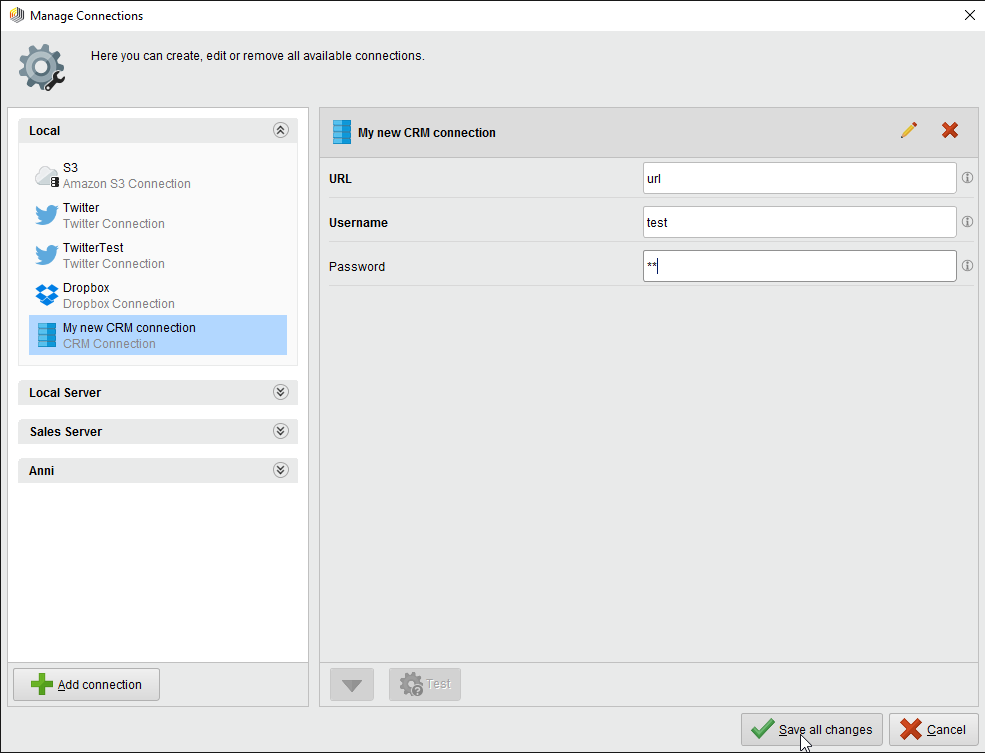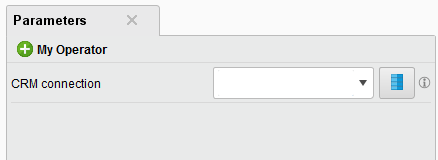You are viewing the RapidMiner Developers documentation for version 9.4 -Check here for latest version
Creating Custom Configurators
This mechanism has been deprecated in RapidMiner 9.3 and should not be used anymore for new extensions! Use the new connection framework in thecom.rapidminer.connectionpackage instead.
Imagine that you want to create a RapidMiner extension that offers an operator for reading data from a CRM system. Your operator needs the information for accessing the CRM, such as a URL, a user name, or a password. One approach is to add text fields to the parameters of the operator and let the user type in the required information. Though this may seem convenient, it gets quite redundant if you want to use the same information in other RapidMiner processes or operators, since you would have to enter the information multiple times. Alternatively, you can define the CRM connection globally and let the user select which CRM to get data from.
This is a scenario whereConfiguratorscome in handy. A configurator globally manages items of a certain type globally and allows you to create, edit and delete them through a custom configuration dialog. For this example, we will implement a configurator for CRM entries that allows us to automatically configure those entries using a dialog accessible through the连接menu. Moreover, a configurator can be used along with a drop-down list, which allows the user to easily select a connection via a parameter of your operator.
Usage
In order to implement your own configurator, you need to know the following classes:
- Configurableis an item that can be modified through aConfigurator.
- Configuratorinstantiates and configures subclasses ofConfigurable.
- ConfigurationManageris used to registerConfiguratorsin RapidMiner.
- ParameterTypeConfigurableis aParameterTypethat creates a drop-down list for configurators and can be used in the parameter settings of operators.
First, create a new class describing a single CRM connection entry, which implements theConfigurableinterface. Best practice is to extendAbstractConfigurableinstead, because by doing so, you avoid dealing with parameter values. Then, you don't have to write code that deals with the actual configuration:
public class CRMConfigurable extends AbstractConfigurable { @Override public String getTypeId() { return "CRM"; } /** Actual business logic of this configurable */ public CRMConnection connect() { String username = getParameter("user name"); String url = getParameter("URL"); URLConnection con = new URL(url).openConnection(); // ... // do something with the connection } }Next, we have to extend theAbstractConfiguratorclass. Each configurator has a uniquetypeId, a String in order to identify the configurator in RapidMiner and an I18NBaseKey which will be used as the base key for retrieving localized information from the resource file. Also, we want to add someParameterTypesto our Configurator, because they specify how an entry can be edited through the configuration dialog. In our example, we needParameter Types描述URL、用户名和password which should be used for the CRM connection. For that matter, you would simply have to overwrite thegetParameterTypesmethod and add a newParameterTypeString, as shown in the following implementation:
public class CRMConfigurator extends AbstractConfigurator { @Override public Class getConfigurableClass() { return CRMConfigurable.class; } @Override public String getI18NBaseKey() { return "crmconfig"; } @Override public List getParameterTypes(ParameterHandler parameterHandler) { List parameters = new ArrayList(); parameters.add(new ParameterTypeString("URL", "The URL to connect to", false)); parameters.add(new ParameterTypeString("Username", "The user name for the CRM", false)); parameters.add(new ParameterTypePassword("Password", "The password for the CRM")); return parameters; } @Override public String getTypeId() { return "CRM"; } } In addition to the methodsgetTypeId,getI18NBaseKeyandgetParameterTypes, you must also implement the methodgetConfigurableClass, which simply returns the used Configurable implementation class (in this case, the classCRMConfigurable).
Next, add localized information to the resource fileGUIXXX.xml, where 'XXX' is the extension name.
gui.configurable.crmconfig.name = CRM Connection gui.configurable.crmconfig.description = An entry describing a CRM connection. gui.configurable.crmconfig.icon = data.pngTo get access to the new configurator, register it in theConfigurationManager. This step is important because it let's RapidMiner know of the new configurator so that the CRM operator and other parts of RapidMiner can access it. To do this, simply call theregistermethod within the initialization procedure. This should be done in theinitPluginmethod of thePluginInitclass:
public static void initPlugin() { ConfigurationManager.getInstance().register(new CRMConfigurator()); }You can now open theManage Connectionsdialog in the连接menu and create a CRM connection.

现在,使用歌剧的连接作为一个参数tor that connects to the CRM. To do so, override the methodgetParameterTypesand addParameterTypeConfigurable:
@Override public List getParameterTypes() { List types = super.getParameterTypes(); ParameterType type = new ParameterTypeConfigurable(PARAMETER_CONFIG, "Choose a CRM connection", "CRM"); types.add(type); return types; } You have now successfully created your own configurator and can use it to configure CRM entries for your operator.

